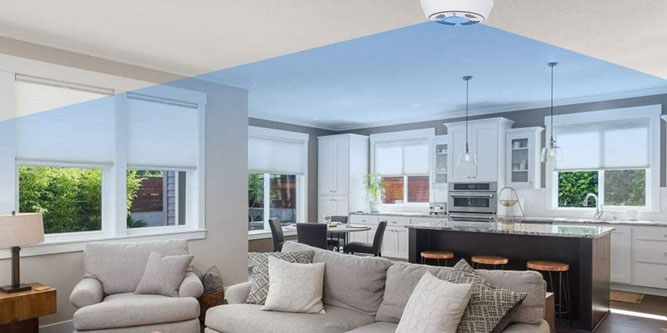Whether you’re renting an apartment or an Airbnb, hidden cameras are a real concern. And as concealment methods go, fake smoke detectors are exceedingly common. So how do you know whether a smoke detector is a hidden camera or the real deal?
There are many ways to determine whether a smoke detector is a camera. Look for telltale signs like a built-in camera lens or non-functioning buttons. You can use your phone to look for infrared light bulbs or suspicious WiFi devices. An RF detector can also be used to detect many types of hidden cameras.
A smoke detector camera can be tough to identify. After all, it’s specifically meant to remain concealed. But if you know what you’re looking for, there are several potential giveaways that you can find. Here are eight ways to determine whether a smoke detector is real or fake.
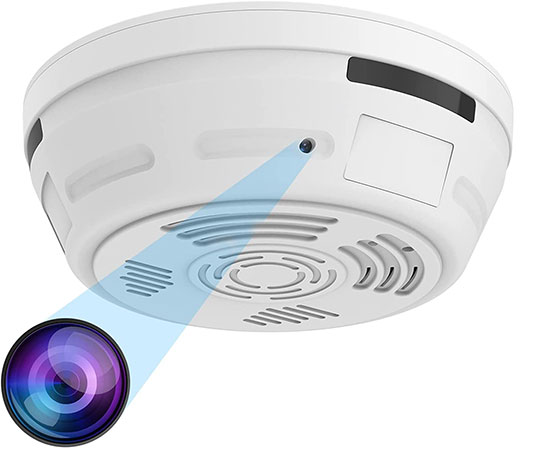
1. Look for a Lens
There are many parts of a camera that are easy to conceal. But one thing that absolutely can’t be covered up is the lens. The lens has to be exposed to whatever the camera is filming. Otherwise, light won’t be able to enter and the camera will be non-functional. And while a hidden camera lens may be tiny, it’s not invisible.
Look at the smoke detector and see if you can identify any type of lens. It will look like the lens on your phone camera, only smaller. You may only be able to see it because it glints when you shine light on it. So use a flashlight while you’re inspecting the camera and see if it reflects off anything.
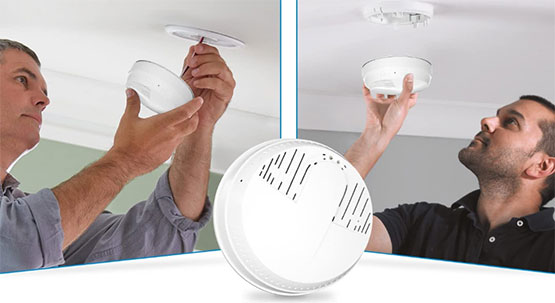
2. Look for Suspicious Wires
Most smoke detectors are battery-powered and don’t require a wire. But even hardwired smoke detectors run on very thin, light gauge wires. They don’t have any big fat cables coming out of them.
Along the same lines, many smoke detector cameras are battery-powered. But battery-powered cameras typically only run for a few hours before dying. A continuously-operating camera will need a constant supply of power. There may even be a USB data cable or an Ethernet cable. Make sure to look under the smoke detector cover. It’s not as if someone will leave the wires running down the outside of their wall.
3. Look for Wall-Mounted Smoke Detectors
A smoke detector can be mounted either on the wall or on the ceiling. Smoke detector cameras, on the other hand, are almost always wall-mounted. Putting one on the ceiling would give it a poor vantage point for covering an entire room.
This isn’t to say that every wall-mounted smoke detector is a camera. Most are just smoke detectors. But pay extra attention to smoke detectors on walls with a full view of the room. If there’s a hidden camera, that’s where it will be.

4. Make a Phone Call
Many smoke detector cameras use an RF wireless signal to communicate with their base station. This signal can interfere with your phone signal when you’re right next to the camera. So call up a friend or family member and walk around the room. See if the signal cuts out when you’re in a particular area. If it does, there’s a good chance you’re dealing with a hidden camera.
Make sure to repeat this test a few times to make sure you get the same results. Your phone should lose signal consistently when you get closer to the smoke detector. If it’s inconsistent, you’re not dealing with a hidden camera. You’re just getting poor reception.
5. Scan For WiFi-Connected Devices
If the camera doesn’t transmit a signal via radio, it’s most likely an IP camera. This means that it transmits video via a WiFi signal. If you can get on the WiFi network, some smartphone apps will let you see other connected devices. Be careful when choosing an app, since some are pretty shady. You should also recognize that this is the type of app you need to pay for.
Within the app, look at other devices that are connected to the network. Anything that says “IP camera” or something similar should stand out like a sore thumb. But you should also look for major camera brands like Nest, Wyze, or Arlo.

6. Use Your Smartphone Camera
This won’t work with all phones, but it will work if your camera has infrared night vision. If it does, you might be able to detect a hidden camera. The key word here is “might.” Different night vision cameras use different types of technology, but some have built-in infrared bulbs. These are invisible to the naked eye, but show up bright as day on an infrared camera.
Note that some smartphones have infrared blocking filters on one or both cameras. You can test this by operating an infrared remote in front of them and seeing if it lights up. Do this in the dark if you want to get any results. Once you determine which – if either – of your cameras is IR-sensitive, you’re ready to inspect the smoke detector.
With the lights off, look all over the housing for infrared lights. In most cases, there won’t be just a single light. There may be as many as a dozen of them, usually in a ring around the camera lens. While you’re at it, this is a good opportunity to inspect the entire room. The smoke detector is just one of many places where a camera might be hidden.
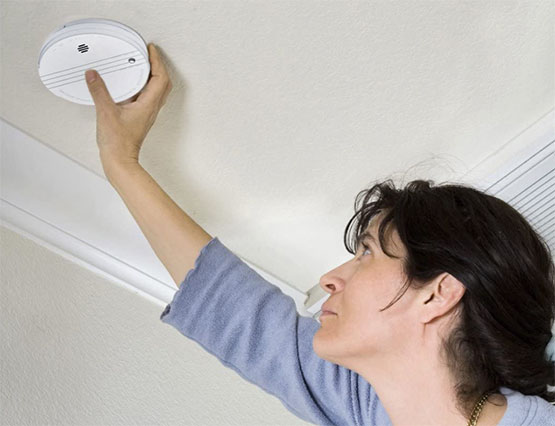
7. Test the Smoke Detector
Smoke detector cameras don’t actually function as smoke detectors. So press any buttons, and see if they do anything. Most real smoke detectors only have a single button that beeps when you press it. Any extraneous buttons are very suspicious. Along the same lines, inspect the entire housing for warning labels. A smoke detector camera will typically have a sticker on the back that says it’s non-functioning.
If you’re feeling adventurous, you can even strike up a match and blow it out just below the smoke detector. See if the resulting puff of smoke causes an alarm to sound. If it doesn’t, you may be dealing with a camera, not a smoke detector.
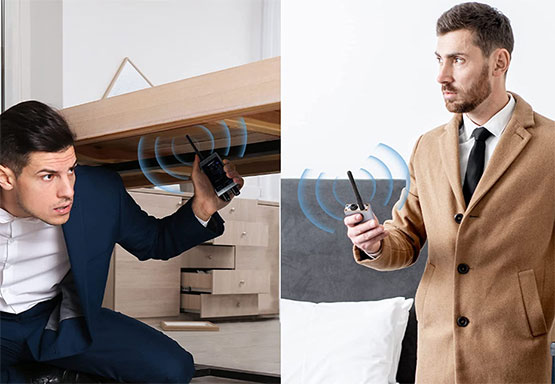
8. Use an RF Signal Detector
Not all RF signals are powerful enough to interfere with your phone reception. So if you want to be truly sure that there aren’t any bugs, you need to use a more sensitive detection system. An RF bug detector is the perfect tool for the job. It will pick up any radio signals and give an audible or visual indicator when the signal is strongest. This allows you to pinpoint the source of any RF signal.
Not long ago, we made a list of the best RF bug detectors. They’re relatively affordable, and you can take one with you whenever you go on the road.
Bear in mind that there are many legitimate sources of RF signals. If your phone, tablet, or router is setting of the detector, that’s normal. But if it starts beeping when you wave it next to the smoke detector, that’s exceedingly suspicious.
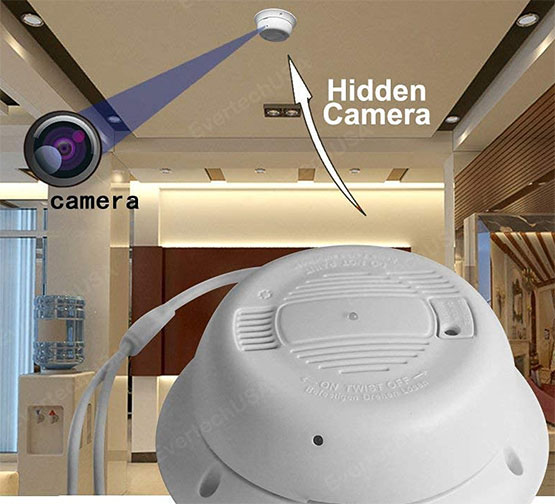
Spy Camera Laws and Rules
Before we wrap up, let’s talk about the laws and other rules surrounding hidden cameras. In the US, laws will vary from state to state. However, it’s illegal to place a hidden camera anywhere where privacy is normally expected. This means you can’t put them in bathrooms, bedrooms, changing rooms, or other similar areas. The exception would be putting a camera in a room that’s privately owned and used by you.
So depending on your state, it might not be illegal for your landlord to hide a camera in your living room. But it would always be illegal for them to put a hidden camera in a bedroom or other private space. That said, a hidden camera is still private property. You can cover it up or even call the police and file a report. But destroying or damaging the camera is still vandalism, and could get you in trouble.
In addition, Airbnb hosts and renters should be aware of additional rules on that platform. Airbnb hosts can only place cameras in non-private areas like kitchens or living rooms. Even then, it can’t be a “sleeping area.” So if you let people sleep on your sofa bed, a living room camera is also out. Hosts must also notify guests of the location of any recording devices, even if they’re not active. And they must always notify guests if the camera is actively recording. So if you find a hidden camera in your Airbnb rental, report your host to the platform.
Final Thoughts
Determining whether or not a smoke detector is a hidden camera can be easy. It can also be difficult, depending on the quality of the manufacture. But by using these eight methods, you should be able to figure out what you’re dealing with.
Meet Ry, “TechGuru,” a 36-year-old technology enthusiast with a deep passion for tech innovations. With extensive experience, he specializes in gaming hardware and software, and has expertise in gadgets, custom PCs, and audio.
Besides writing about tech and reviewing new products, he enjoys traveling, hiking, and photography. Committed to keeping up with the latest industry trends, he aims to guide readers in making informed tech decisions.

